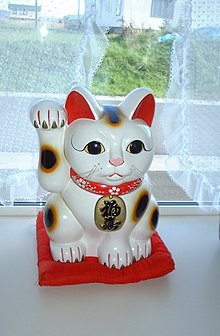Maneki Neko

Maneki Neko (招き猫, literally "beckoning cat"), also known as "welcoming cat", "lucky cat", "money cat" or "fortune cat", is a common Japanese figurine. It is a lucky charm. This small statue is found in many Japanese shops,[1] and it is also seen in some places outside Japan.
Maneki neko is usually painted as a Calico cat (Japanese Bobtail), but new colors has appeared recently (for example, white, red, black, pink, blue and gold). It usually has the right paw raised. Some of these statues have the left paw raised.
The statue commonly has a gold coin called a koban around the cat's neck.
Tokoname in Aichi Prefecture is Japan's top producer of Maneki neko.[2]
Color
[change | change source]This is the meaning of the colors
- red, black; avoid getting ill
- pink; help his or her love
- gold; be lucky with money
- calico; traditional color
Gesture
[change | change source]Maneki-neko can be found with either the right or left paw raised (and sometimes both). Generally, a right paw raised brings good luck and wealth, while the left paw raised brings in customers.
History
[change | change source]Maneki neko was a mascot of the silk industry, but now it is considered to be a mascot of business prosperity. Different theories say that the Maneki neko came from Imado temples or that it came from Gotoku temples.
Related pages
[change | change source]References
[change | change source]- ↑ Nussbaum, Louis-Frédéric. (2005). "Maneki Neko" in Japan Encyclopedia, p. 606.
- ↑ "Tokoname, Birthplace of Manekineko Lucky Cats" at Virtualtourist.com Archived 2013-06-08 at the Wayback Machine; excerpt, "About eighty percent of this type of cat figurines are produced in Tokoname...". Retrieved 2012-12-4.
Other websites
[change | change source]![]() Media related to Maneki neko at Wikimedia Commons
Media related to Maneki neko at Wikimedia Commons
- "Giant Maneki Neko....Tokoname Japan" at Panoramio Archived 2016-10-17 at the Wayback Machine
